5.6 Surviving a Volcanic Eruption
As frightening as some volcanic eruptions can be, people survive them all the time. You should never rely solely on luck, the knowledge of others, or city policy to survive an eruption; if you live in an area that is prone to this deadly hazard, there are plenty of precautions you can personally take to ensure that the odds are in your favor when you, your family, or your friends are affected by a volcanic eruption.
Volcanic Hazard Zones
After reading all that you have, you may wonder why anyone in their right mind would live near an active volcano! The reasons are complex, and after millions upon billions of dollars have been invested in building a town with emotional and spiritual significance for its residents, relocating from a hazardous area is rarely ever an option. Instead, it is useful to determine the likelihood that certain areas around the volcano will experience hazards like lava flows, lahars, pyroclastic flows, and more should the worse happen.
Geologists do not just closely monitor volcanoes to predict when they will erupt. They also create hazard maps around the volcano that accessible to the public, as shown in the example of Hawaii (below).

These maps summarize the regions that should be evacuated if a volcanic eruption is imminent. If you happen to visit a place with an active volcano such as Hawaii, or have family living in such an area, it is a good idea to check whether they live in an area that would be most threatened by volcanic activity. In general, any community or city that is downslope from the volcano should pay careful attention to announcements about that volcano and potential evacuation orders [11].
Have A Plan

Never allow yourself to be unprepared for a potential disaster. This statement is true of any situation; volcanoes, earthquakes, landslides, flooding, etc. Although your community should have a plan to mitigate the damage from a natural hazard at the city and state level, those policies are not a substitute for how you will personally react to a spontaneous disaster. If you live in a region affected by volcanoes, make sure that you do the following:
- Research the layout of your community and the geologic risks to it. Figure out a safe place that is likely to be less affected by a volcanic eruption and its hazards that you can quickly relocate to.
- Communicate the risks of a volcanic eruption to your family. Work together with them to come up with an emergency plan that each member will carry out should an eruption unexpectedly happen.
- Factor in unknowns such as family members getting separated or traffic blockages into your plan. Make sure everyone knows the way to your safe meeting place.
- Put together an Emergency Kit that contains at least a 3-day supply of food and water for everyone. Volcanoes, in particular, spew ash that is dangerous if inhaled. Make sure you add N95 face masks to this kit for you and your family members! [12]
BUILDING AN EMERGENCY PREPAREDNESS KIT
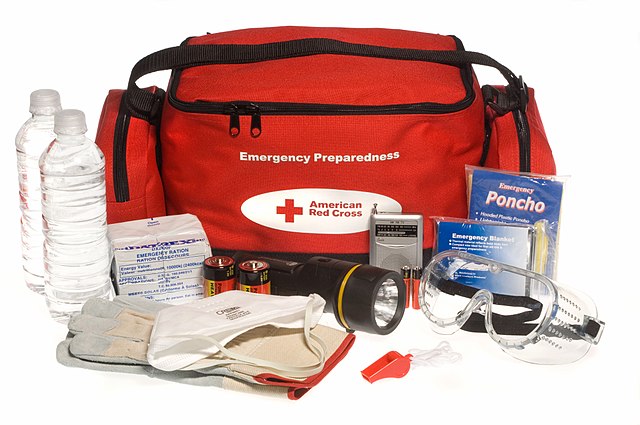
Having an emergency preparedness kit ready in your home is a great first step toward surviving any potential disaster. They may look really expensive at stores or online (such as the basic kit pictured above), but you can put together a really effective kit by yourself that may keep you and your loved ones safe!
How Build Your Own Kit
Look for the basics around your home before you start buying costly equipment. Just make sure that equipment still works before you put it together in your kit! Make sure you have the following:
- Non-perishable food that does not require fuel sources (i.e. microwave/oven) that can last up to 72 hours per person. Think food bars and canned food! Don’t forget a can opener!
- 1 Gallon of water for each person to last every day of the emergency. This amount should be about 3 gallons per person to last 72 hours.
- A flashlight with extra batteries.
- A radio! Many updates come on radio and they are more reliable if cell towers come down. There are also hand-crank powered radios that can be useful in a pinch!
- Personal protective equipment: face masks, goggles, and gloves will keep you safe and free from contamination and disease.
- Emergency cash: consider an emergency that knocks out the power grid and affects basic utilities, including the ability to pay electronically.
- Toilet paper and other sanitation products
- If applicable: Personal medications, pet food, solar chargers, flares, whistle, hand tools
When in doubt, go to https://ready.gov/kit/ for advice!
During the Eruption
Be sure that you are periodically monitoring updates from your local scientists on whether your volcano is becoming active. If there is some unrest, you will hear about it early, and have some time to prepare and perhaps evacuate!
If you are right near or on the volcano…
Hopefully this won’t apply to you! However, if you are in the worst case scenario of hiking a volcanic summit when it erupts, you can STILL protect yourself.
- Move away from the volcano as quickly as you can!!
- Do NOT walk into any low-lying areas such as washes, ditches, valleys, etc. These are places that are prone to lava flows or lahars.
- Carefully read the signage posted by the forestry service as you go. You might be able to receive the life-saving information that a certain route is blocked off or closed! [13]
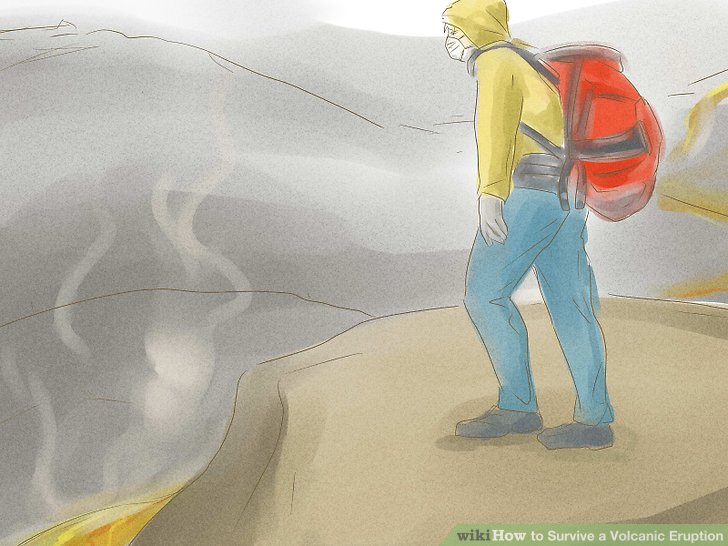
If you are downslope of the volcano…
This situation often applies to residents in the valley surrounding a volcano who have refused to evacuate or an area that has not sent out evacuation orders.
- Do NOT drive! The ash falling from volcanoes can clog engines and ruin infrastructure. Driving during an eruption should be your last resort.
- Seal your windows and doors. If your area is not affected by lahars and lava flows, it still might be affected by falling ash. Prevent it from getting into your home by taping off your windows and doors and shut off your HVAC system (or limit it as much as possible!).
- Avoid the lowest relief areas such as valleys, channels, washes, ditches, etc. These are the places where lahars and/or lava flows are likely to be, and therefore the most hazardous!
- Listen for announcements by officials and scientists about potential lahar warnings, lava flows, and other hazards. They will also let you know when it is safe to go outside or relocate. Using a radio for this is the most reliable method as cell phone towers and internet will be unreliable. [13]
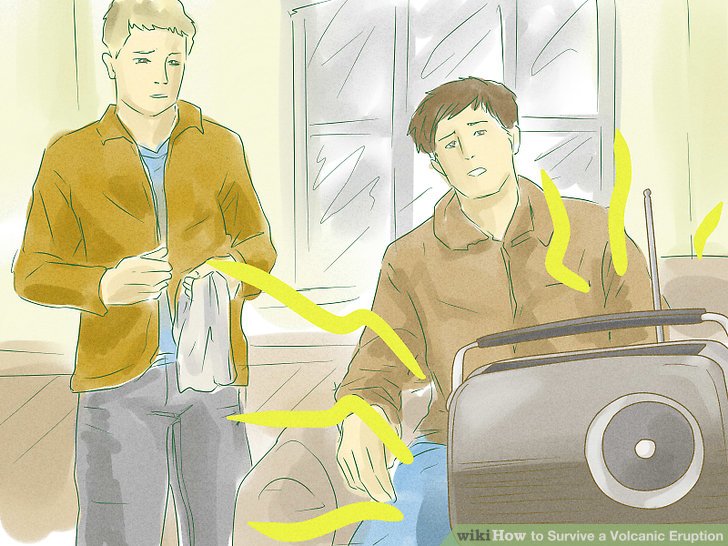
After the Eruption
- Do NOT approach cooling lava! It may look black and safe, but lava is insanely hot at temperatures over 1000°C. Appearances are deceiving, and sometimes lava is only cooled at the very surface.
- Avoid all areas around a potential lahar zone! These flows take a long time to solidify and they may occur repeatedly.
- Avoid cleaning your roof of ash–allow professionals to do this, and certainly do not attempt it until the ash has finished falling. If there is a significant amount of ash on your roof (multiple feet), consider evacuating for safety as the weight of ash can cause collapses.
- If you have breathing problems, continue to wear a mask to keep your airways safe from the unconsolidated ash deposits.
- Keep monitoring your area for announcements and potential secondary hazards that could make the eruption effects worse, such as rainstorms. [14]
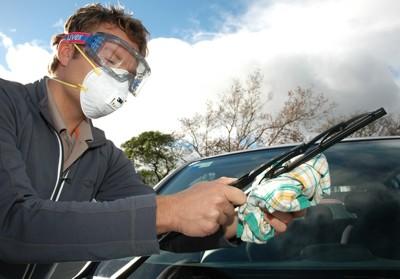
***See 5.8 for Text and Media Attributions
A region along Earth's lithosphere where at least two tectonic plates move apart from one another.
We may receive all the heat we need on the Earth's surface from sunlight, but if you dig a hole just a few feet deep, you might notice that the surrounding soil is much cooler. This happens because much of the sediment is insulated from the sun's energy. Nevertheless, if you had the ability to dig miles and miles into the crust, you would find that the temperature of the rock would start to significantly increase!

This increase in temperature with depth in the Earth's crust is called the geothermal gradient. In general, we can expect temperatures to increase about 25°C for each kilometer of depth. This sounds like a significant increase in heat, but once we pass the 100 km mark, temperatures really take off!
As we learned in the second chapter, the Earth's iron core is wickedly hot! Such heat powers plate tectonics, and when combined with other factors, it can lead to partial melting in the upper mantle. This melted, molten rock occasionally rises to the Earth's surface and when it does, watch out!
A volcano will form above a chamber or plume of magma. There is a wide variety of volcanoes, and some are more explosive than others. Molten lava is far from the only hazard; volcanic eruptions can cause massive damage with ashfall, pyroclastic flows, toxic gases, and deadly landslides. There are even a few volcanoes considered so dangerous that they are termed "supervolcanoes", and they have the potential to drastically impact society for generations.
Although volcanoes are hazardous, they are a continuous boon for the global economy. The precious minerals and useful rocks formed by volcanic processes have benefited civilization for thousands of years. In the modern economy, we use volcanism as a source of alternative energy and igneous rocks in trades ranging from construction to cosmetics.
Learning Objectives
- Describe the size, shape, and eruption style of volcanoes and how they form/
- Identify the major volcanic hazards and their effects on humans and property.
- Explain how scientists monitor volcanoes and where volcanoes can be found.
- Explain how volcanic processes benefit society.
molten rock that has erupted at the Earth's surface due to volcanic processes.
It’s important to classify slope failures so that we can understand what causes them and learn how to mitigate their effects. The three criteria used to describe slope failures are:
- Material: Type of material that failed (typically either bedrock or unconsolidated sediment)
- Motion: How the material moved (fall, slide, or flow).
- Rate: Speed at which the material moved.
Three types of motion associated with slope failure are:
- Fall: Material drops through the air, vertically or nearly vertically.
- Slide: Material moves as a cohesive mass along a sloping surface.
- Flow: Material moves like a fluid.
Unfortunately it’s not normally that simple. Many slope failures involve two of these types of motion, some involve all three, and in many cases, it’s not easy to tell how the material moved. The types of slope failure that we’ll cover here are summarized in Table 11.1, though there are other types of mass wasting.
| [Skip Table] | |||
| Failure Type | Type of Material | Type of Motion | Rate of Motion |
|---|---|---|---|
| Rock fall | Bedrock | Fall | Extremely rapid |
| Rock slide | Bedrock | Slide | Very slow to extremely rapid |
| Rock avalanche | Bedrock (slides then breaks into smaller fragments) | Flow | Extremely rapid |
| Creep or solifluction | Unconsolidated materials (rock fragments, soils) | Flow or slide | Extremely slow |
| Slump | Unconsolidated sediments | Slide | Very slow to moderate |
| Mudflow | Unconsolidated sediments (very small silt and clay) | Flow | Moderate to Extremely rapid |
| Debris flow | Unconsolidated sediments (Sand, gravel, and larger fragments) | Flow | Rapid to Extremely rapid |
Rock Fall
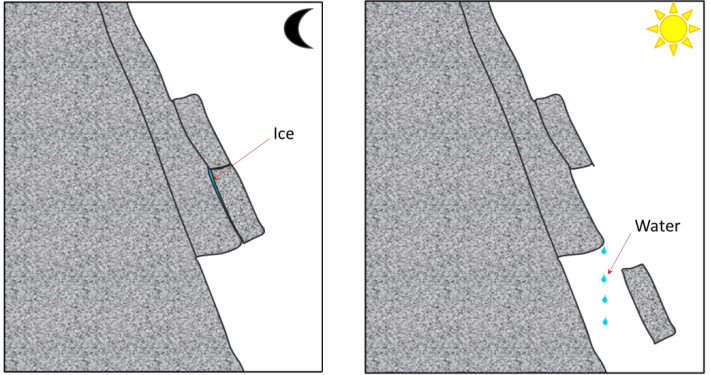
Rock fragments can break off relatively easily from steep bedrock slopes, most commonly due to frost-wedging in areas where there are many freeze-thaw cycles per year. When water freezes to form ice, its volume increases by about 8%, this causes fractures to enlarge. When the ice melts, more water can fill the larger crack, and refreeze. This process over time can cause large pieces of solid rock to fall (Fig 11.2.1). However, it can occur due to other triggers, particularly heavy rain, which adds weight or loosens material.
A rock fall in Verde Valley, Arizona, caused tons of solid material to fall to the valley below, destroying an RV but stopping short of hitting the house (Figure 11.2.2). Luckily no one was hurt in this rock fall, but living at the base of a cliff can be very dangerous and a fall is likely to happen again.
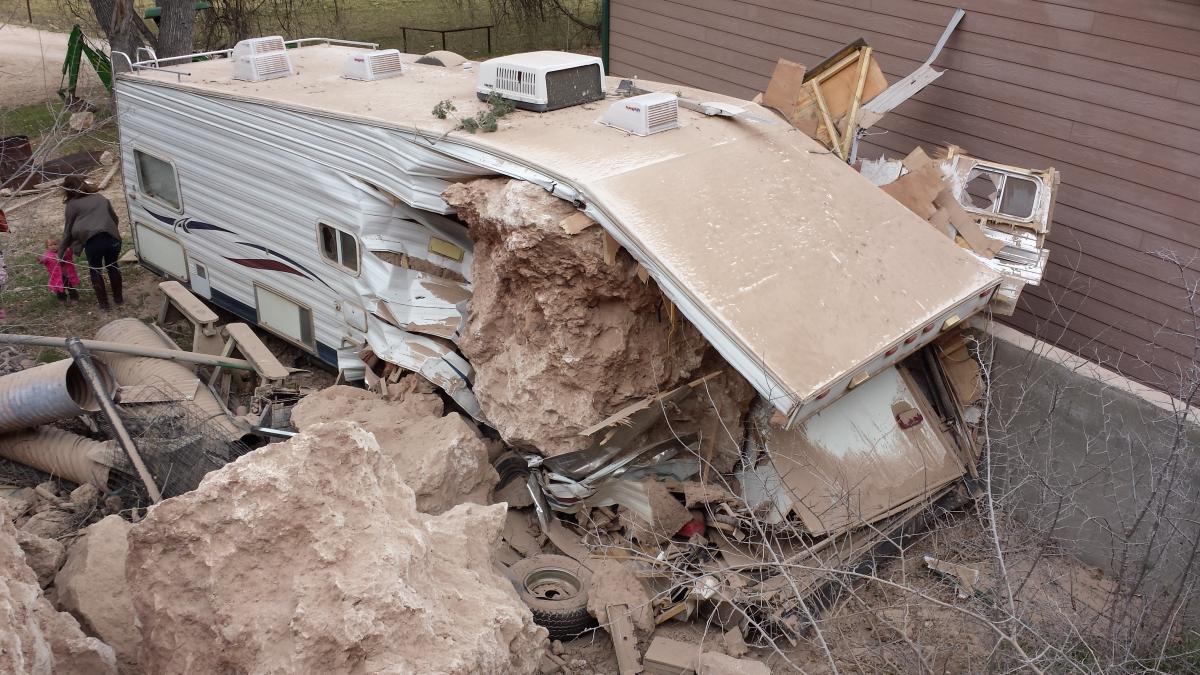
Rock Slide
A rock slide is the sliding motion of rock along a sloping surface. In most cases, the movement is parallel to a fracture, bedding, or metamorphic foliation plane, and it can range from very slow to moderately fast.
On June 23, 1925, a 38 million cubic meter rock slide occurred next to the Gros Ventre River (pronounced “grow vont”) near Jackson Hole, Wyoming. Large boulders dammed the Gros Ventre River and ran up the opposite side of the valley several hundred vertical feet. The dammed rivercreated Slide Lake, and two years later in 1927, lake levels rose high enough to destabilize the dam. The dam failed and caused a catastrophic flood that killed six people in the small downstream community of Kelly, Wyoming.

A combination of three factors caused the rock slide: 1) heavy rains and rapidly melting snow saturated the sandstone causing the underlying shale to lose its shear strength, 2) the Gros Ventre River cut through the sandstone creating an <span class="glossaryLink" style="border-bottom: 1px dotted #000000 !important;text-decoration: none !important;color: #000000 !important" aria-describedby="tt" data-cmtooltip="
">oversteepened slope, and 3) soil on top of the mountain became saturated with water due to poor drainage. The cross-section diagram shows how the parallel bedding planes between the sandstone and clay/limestone offered little friction against the slope surface as the river undercut the sandstone. Lastly, the rockslide may have been triggered by an earthquake. (3)
Rock Avalanche
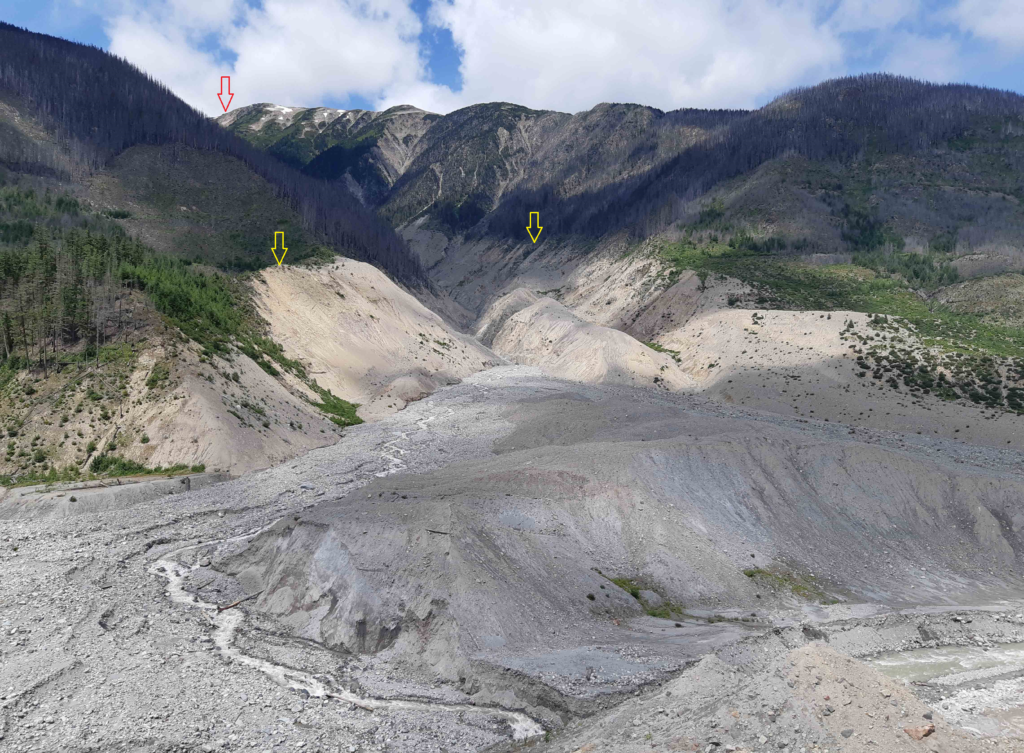
If a rock slides and then starts moving quickly (meters per second), the rock is likely to break into many small pieces, and at that point it turns into a rock avalanche in which the large and small fragments of rock move in a fluid manner supported by a cushion of air within and beneath the moving mass. The 2010 slide at Mount Meager (north of Vancouver, British Columbia, Canada) was a rock avalanche, and is the largest slope failure in Canada during historical times (Figure 11.2.5). Though no one was harmed during this event, there is a great potential for damage and loss of life from this type of mass wasting. (1)
Creep or Solifluction
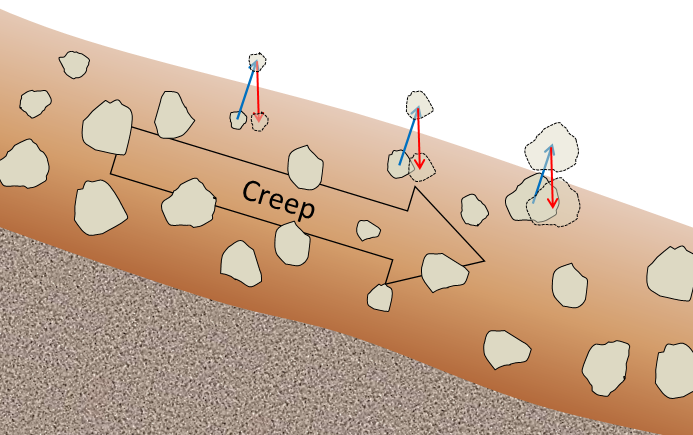
The very slow—millimeters per year to centimeters per year—movement of soil or other unconsolidated material on a slope is known as creep. Creep, which normally only affects the upper several centimeters of loose material, is typically a type of very slow flow, but in some cases, sliding may take place. Creep can be facilitated by freezing and thawing because, as shown in Figure 11.2.6, particles are lifted perpendicular to the surface by the growth of ice crystals within the soil, and then let down vertically by gravity when the ice melts. The same effect can be produced by frequent wetting and drying of the soil. In cold environments, solifluction is a more intense form of freeze-thaw-triggered creep. Creep is most noticeable on moderate-to-steep slopes where trees, fence posts, or grave markers are consistently leaning in a downhill direction. In the case of trees, they try to correct their lean by growing upright, and this leads to a curved lower trunk, shown on Figure 11.2.7.

Slump
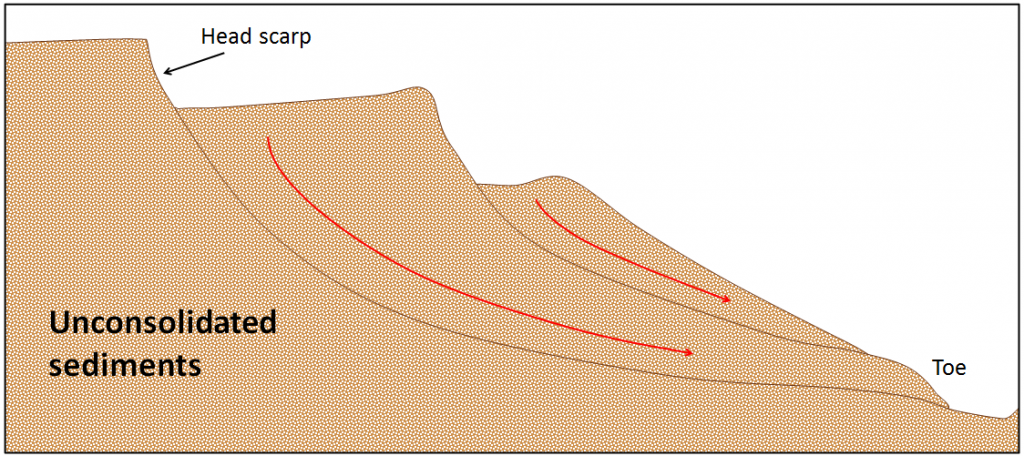
Slump is a type of slide (movement as a mass) that takes place within thick unconsolidated deposits (typically thicker than 10 meters). Slumps involve movement along one or more curved failure surfaces, with downward motion near the top and outward motion toward the bottom (Figure 11.2.8). They are typically caused by an excess of water within these materials on a steep slope.
An example of a slump in the Lethbridge area of Alberta is shown in Figure 11.2.9. This feature has likely been active for many decades, and moves a little more whenever there are heavy spring rains and significant snowmelt runoff. The toe of the slump is failing because it has been eroded by the small stream at the bottom.
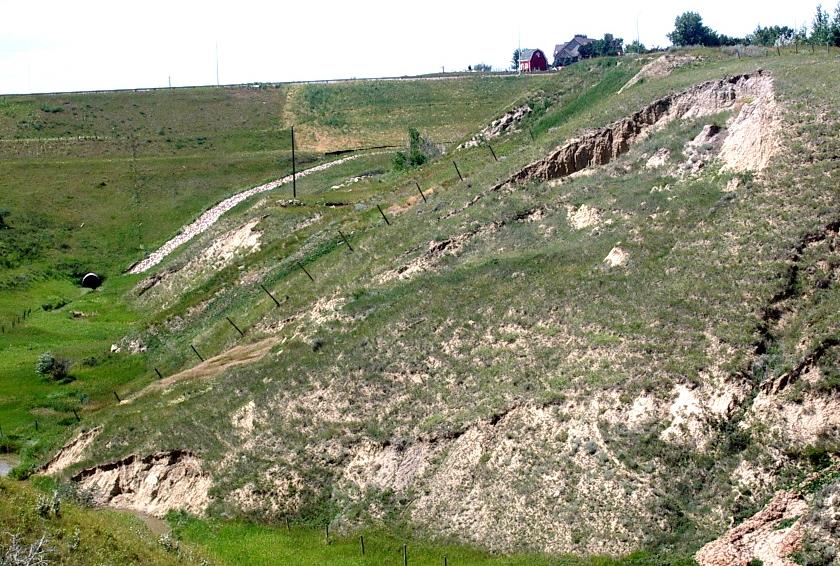
Mudflows and Debris Flows

As you saw previously, when a mass of sediment becomes completely saturated with water, the mass loses strength, to the extent that the grains are pushed apart, and it will flow, even on a gentle slope. This can happen during rapid spring snowmelt or heavy rains, and is also relatively common during volcanic eruptions because of the rapid melting of snow and ice. (A mudflow or debris flow on a volcano or during a volcanic eruption is a lahar.) If the material involved is primarily sand-sized or smaller, it is known as a mudflow, such as the one shown in Figure 11.2.10.
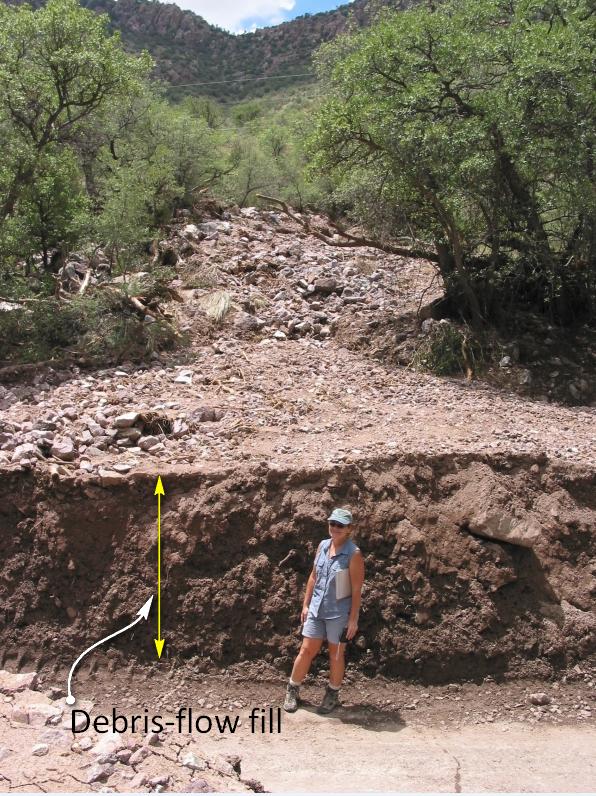
If the material involved is gravel sized or larger, it is known as a debris flow. Because it takes more gravitational energy to move larger particles, a debris flow typically forms in an area with steeper slopes and more water than does a mudflow. In many cases, a debris flow takes place within a steep stream channel, and is triggered by the collapse of bank material into the stream. This creates a temporary dam, and then a major flow of water and debris when the dam breaks. Large amounts of debris can be carried.
volcanically ejected rock fragments or particles that are less than 2 mm.

